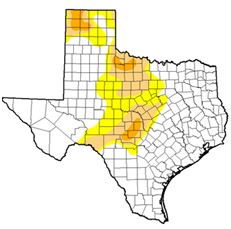By Stephen Janak, County Extension Agent – Ag/Natural Resources
Have you had enough yet? We’ve gotten some serious rain since fall, leaving most everyone waterlogged and saturated – and there’s more on the way. The forecast has rain chances every day for the foreseeable future. So what effect has all of this rain had on area agriculture, and what effect will additional rain have on the rest of the growing season?
For one thing, the rains have brought most of the state “out of the drought,” at least according to the United States Drought Monitor. The U.S. Drought Monitor is jointly produced by the National Drought Mitigation Center at the University of Nebraska-Lincoln, the United States Department of Agriculture, and the National Oceanic and Atmospheric Administration. While the rain has helped replenish soil moisture in the upper Gulf Coast, rainfall and runoff have still not been sufficient to fill the reservoirs of the Highland Lakes region. As of May 22nd, Lake Buchanan and Lake Travis are still at 39% and 44% of capacity, respectively. This means that farmers in our area are still not likely to receive irrigation water via the Colorado River.
Additionally, hay producers in Colorado County have had very few chances to cut, dry, and bale hay on time. Even two tenths of an inch of rain is enough to delay baling if conditions are cloudy and the hay stays too wet. As a result, many producers have not cut ryegrass or oats that was grown this winter. This winter forage is now over-mature and has lost some of its nutritive feeding value for livestock. Having this tall standing forage still in fields and pastures also delays or chokes back the spring growth of bermudagrass, as many producers would normally be gearing up for the first cutting of Coastal or Jiggs bermudagrass by this time, instead of just looking at soggy fields.
The rain has also made the preparation of fields and planting of row crops a finicky business. Just a quarter-inch of rain can keep tractors out of fields because planters may plug-up or cake with mud. Overall, however, most farmers have had just enough breaks between wet periods to get most crops in the ground. That being said, the excessive rain has led to standing water and waterlogged conditions. This can result in the loss of nutrients through leeching or even denitrification, which happens when soils are underwater for over 48 hours. Loss of nutrients generally translates to a loss of yield.
If the rain continues through the harvest season, we could possibly experience more difficulties or losses of crop due to excessive moisture in the grain or fiber, or muddy conditions which keep equipment out of the field.
Let’s not curse the rain just yet, but maybe tell it to just stay northwest of Austin for now.
May 19, 2015
Map courtesy of NDMC-UNL.


